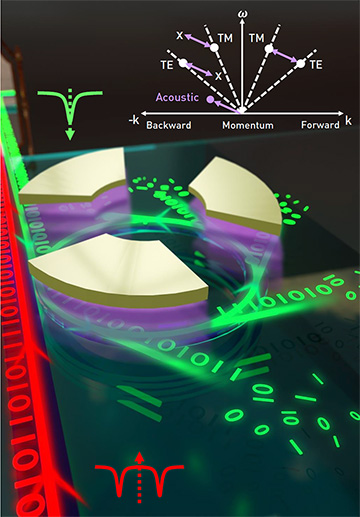 A Si3N4 microring resonator with three monolithically integrated AlN piezoelectric modulators breaks optical transmission reciprocity without an external magnetic field. Strong acousto-optic modulation allows indirect interband transition between a pair of strongly coupled (TE and TM) optical modes in only one direction. [Enlarge figure]
A Si3N4 microring resonator with three monolithically integrated AlN piezoelectric modulators breaks optical transmission reciprocity without an external magnetic field. Strong acousto-optic modulation allows indirect interband transition between a pair of strongly coupled (TE and TM) optical modes in only one direction. [Enlarge figure]
The compactness, robustness and low power consumption of integrated photonics offer an elegant way to bring tabletop optical systems from the research lab to daily life. Advances in nanofabrication technology have enabled the integration of important building blocks, from integrated laser sources to optical modulators to photodetectors. Moreover, tight confinement of light in optical waveguides allows the exploration of optical nonlinearities, including optical-frequency-comb, second-harmonic and supercontinuum generation. In recent work, we have developed a key building block for future compact systems: an integrated silicon nitride (Si3N4) optical isolator free of the need for external magnetic fields.
Over the past decade, Si3N4 has become a leading material platform for integrated photonics, benefiting from record low loss, large Kerr nonlinearity and compatibility with foundry processes.1 Si3N4 has been widely used for Kerr frequency combs, microwave photonics and photonic computing networks. Meanwhile, high-quality-factor Si3N4 microresonators have recently been used in integrated semiconductor lasers with linewidths comparable to those of commercial fiber lasers.2
Despite these advanced functionalities, nonreciprocal integrated optical devices have posed challenges. Traditionally, optical nonreciprocity is based on the Faraday effect of magneto-optic materials under an external magnetic field.3 Such a system, which requires a bulky external magnet, is still challenging for chip-scale integration. Magnetic-free operation is thus highly desired, and has been extensively studied based on optical nonlinearities, stimulated Brillouin scattering and optomechanically induced transparency. These approaches, however, are limited by dynamic reciprocity, high required optical pump power or narrow bandwidth.
Our team was able to break Lorentz reciprocity and time-reversal symmetry via spatio-temporal modulation4 of an integrated Si3N4 microring resonator with three monolithically integrated aluminium nitride (AlN) piezoelectric modulators.5 Bulk acoustic waves are launched vertically, which modulate the Si3N4 optical waveguide through the stress-optic effect. When driving the three piezoelectric actuators with rotational relative phases, an effective rotating acoustic wave is generated that carries in-plane momentum. A pair of transverse electric (TE) and transverse magnetic (TM) optical modes are designed with closely spaced frequency and momentum that match the effective acoustic wave.
The strong acousto-optic modulation induces indirect interband transition between the two optical modes in the forward direction, where the phase matching is satisfied. The strong mode coupling creates Rabi mode splitting and a transparency window at the center wavelength. In the backward direction, however, the device retains a single resonance and absorbs the incoming light. With only 300 mW of RF power, up to 98% of light is transmitted in the forward direction, while 90% of the backward light is absorbed. We demonstrated unidirectional transmission of optical pulses with isolation bandwidth of 700 MHz.
We believe that our magnetic-free, electrically driven optical isolator, made of materials compatible with foundry processes, should be easily integrated with other photonic components, and thus can work as a key building block for future compact optoelectronic systems.
Researchers
Hao Tian and Sunil A. Bhave, Purdue University, West Lafayette, IN, USA
Junqiu Liu, Anat Siddharth, Rui Ning Wang, Terence Blésin, Jijun He and Tobias J. Kippenberg, Swiss Federal Institute of Technology Lausanne (EPFL), Lausanne, Switzerland
References
1. D.J. Moss et al. Nat. Photon. 7, 597 (2013).
2. W. Jin et al. Nat. Photon. 15, 346 (2021).
3. W. Yan et al. Optica 7, 1555 (2020).
4. Z. Yu and S. Fan. Nat. Photon. 3, 91 (2009).
5. H. Tian et al. Nat. Photon. 15, 828 (2021).
